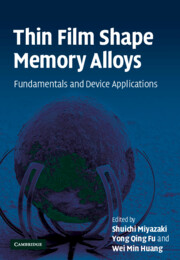Book contents
- Frontmatter
- Contents
- List of contributors
- Preface
- Abstracts of chapters
- 1 Overview of sputter-deposited TiNi based thin films
- 2 Martensitic transformation in TiNi alloys
- 3 Deposition techniques for TiNi thin film
- 4 TiNi multilayer thin films
- 5 Crystallization and microstructural development
- 6 Mechanical properties of TiNi thin films
- 7 Stress and surface morphology evolution
- 8 Ion implantation processing and associated irradiation effects
- 9 Laser post-annealing and theory
- 10 Overview of thin film shape memory alloy applications
- 11 Theory of SMA thin films for microactuators and micropumps
- 12 Binary and ternary alloy film diaphragm microactuators
- 13 TiNi thin film devices
- 14 Shape memory microvalves
- 15 Superelastic thin films and applications for medical devices
- 16 Fabrication and characterization of sputter-deposited TiNi superelastic microtubes
- 17 Thin film shape memory microcage for biological applications
- 18 Shape memory thin film composite microactuators
- 19 TiNi thin film shape memory alloys for optical sensing applications
- Index
19 - TiNi thin film shape memory alloys for optical sensing applications
Published online by Cambridge University Press: 23 February 2010
- Frontmatter
- Contents
- List of contributors
- Preface
- Abstracts of chapters
- 1 Overview of sputter-deposited TiNi based thin films
- 2 Martensitic transformation in TiNi alloys
- 3 Deposition techniques for TiNi thin film
- 4 TiNi multilayer thin films
- 5 Crystallization and microstructural development
- 6 Mechanical properties of TiNi thin films
- 7 Stress and surface morphology evolution
- 8 Ion implantation processing and associated irradiation effects
- 9 Laser post-annealing and theory
- 10 Overview of thin film shape memory alloy applications
- 11 Theory of SMA thin films for microactuators and micropumps
- 12 Binary and ternary alloy film diaphragm microactuators
- 13 TiNi thin film devices
- 14 Shape memory microvalves
- 15 Superelastic thin films and applications for medical devices
- 16 Fabrication and characterization of sputter-deposited TiNi superelastic microtubes
- 17 Thin film shape memory microcage for biological applications
- 18 Shape memory thin film composite microactuators
- 19 TiNi thin film shape memory alloys for optical sensing applications
- Index
Summary
Abstract
This chapter focuses on the optical sensing applications based on TiNi films. When the TiNi film undergoes a phase transformation, both its surface roughness and reflection change, which can be used for a light valve or on–off optical switch. Different types of micromirror structures based on sputtered TiNi based films have been designed and fabricated for optical sensing applications. Based on the intrinsic two-way shape memory effect of free standing TiNi film, TiNi cantilever and membrane based mirror structures have been fabricated. Using bulk micromachining, TiNi/Si and TiNi/Si3N4 bimorph mirror structures were fabricated. As one application example, TiNi cantilevers have been used for infrared (IR) radiation detection. Upon absorption of IR radiation, TiNi cantilever arrays were heated up, leading to reverse R-phase transition and bending of the micromirrors.
Introduction
Optical MEMS, also called MOEMS (Micro-opto-electro-mechanical systems), generally refers to the optical and optoelectronic systems that include one or more micromechanical element [1, 2, 3, 4, 5]. The micromechanical elements in MOEMS are batch fabricated by micromachining techniques. They are smaller, lighter, faster and cheaper than their bulk counterparts, and can be monolithically integrated with the optical components. The digital micromirror device (DMD) from Texas Instruments, USA is a showpiece of optical MEMS [5]. It is an array of mirrors, which are independently addressable and can deflect light through a tristable range of motion (+10°, 0°, –10°), as illustrated in Fig. 19.1 [5]. A light source is directed onto the DMD while a signal is input to the device. Each individual mirror is placed in a binary mode.
- Type
- Chapter
- Information
- Thin Film Shape Memory AlloysFundamentals and Device Applications, pp. 437 - 456Publisher: Cambridge University PressPrint publication year: 2009
- 1
- Cited by



